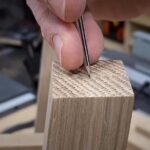Have you ever wondered what woodworking tool cuts circles in wood? Cutting circles in woodworking projects is a common need, and having the right tools for the job can make all the difference. Whether you are working on furniture, cabinetry, or artistic designs, achieving precise and clean circular cuts is essential for the finished product to look professional and polished.
Woodworkers rely on a variety of tools to cut circles in wood, each with its own advantages and disadvantages. From traditional hand tools to modern power tools, there are numerous options available for achieving perfect circular cuts in woodworking projects. Understanding the different tools and techniques for cutting circles is crucial for anyone working with wood, from beginners to experienced craftsmen.
In this article, we will explore the importance of cutting circles in woodworking projects and delve into the various tools available for this purpose. We will discuss traditional methods such as using a compass, jigsaw, and hole saw, as well as modern power tools including routers, band saws, and circle cutters.
Additionally, we will analyze the pros and cons of each tool and provide practical tips for achieving accurate circular cuts while emphasizing safety precautions when using power tools. So let’s dive into the world of cutting circles in wood and discover the best woodworking tool for your next project.
Understanding the Need for Cutting Circles
Woodworking projects often require the cutting of circles in wood to achieve specific design elements or structural requirements. A common example of this is creating table tops, decorative wooden wheels, or circular insets for doors and windows. Cutting circles in wood can have a significant impact on the overall aesthetic and functionality of the finished product, making it an essential skill for woodworkers to master.
In furniture-making, cutting circles in wood is necessary for creating round tabletops or shelves that add visual interest and variety to the piece. Whether it’s a coffee table, dining table, or display shelf, circular elements can soften the linear edges of furniture and create a more inviting and dynamic look. Additionally, wooden wheels and knobs are often used in cabinetry and other woodworking projects, requiring precise circular cuts to ensure smooth operation and aesthetic appeal.
In architectural woodworking, cutting circles in wood may be necessary for creating circular insets in doors or windows for decorative purposes. These circular details can add character and charm to a building’s interior or exterior, enhancing its overall design. Furthermore, wooden sculptures and art installations often incorporate circular shapes, requiring accurate cutting techniques to bring the artist’s vision to life.
Overall, mastering the skill of cutting circles in wood is essential for achieving precision and creativity in various woodworking projects. The ability to create clean and accurate circular cuts can elevate the finished product’s visual appeal while ensuring structural integrity and functionality. What woodworking tool cuts circles in wood will depend on the specific project requirements and the woodworker’s level of expertise with different cutting tools.
Traditional Methods for Cutting Circles
When it comes to woodworking, cutting circles in wood has been a necessary skill for centuries. Before the advent of modern power tools, craftsmen and artisans relied on traditional methods and tools to achieve perfect circular cuts. In this section, we will explore the historical methods and tools used for cutting circles in wood, including the compass, jigsaw, and hole saw.
The Compass Method
One of the earliest methods for cutting circles in wood is using a compass. Craftsmen would use a compass to draw a perfect circle on the wood surface before using hand tools such as chisels or saws to carefully cut along the traced line. This method required great precision and skill to ensure that the circular cut was clean and accurate.
The Jigsaw Technique
Another traditional tool for cutting circles in wood is the jigsaw. The jigsaw allows craftsmen to maneuver around the traced circle and make precise cuts with ease. By carefully following the drawn line, craftsmen can create perfectly round shapes in wood using this handheld power tool.
The Hole Saw Approach
For larger circular cuts, craftsmen would use a hole saw – a specialized tool designed for cutting holes in wood. The hole saw consists of a cylindrical saw attached to a drill, allowing for efficient and accurate cutting of larger diameter circles. This method was especially useful when creating holes for pipes or dowels in woodworking projects.
These traditional methods have paved the way for modern woodworking techniques but are still valuable skills that every craftsman should master. Each method has its advantages and disadvantages, making it important to understand how to choose the most appropriate tool based on specific project requirements and desired outcomes.
Modern Tools for Cutting Circles
When it comes to woodworking, the ability to cut perfect circles in wood is essential for many projects. Whether you’re working on furniture, decorative items, or even musical instruments, achieving precise circular cuts can make a significant impact on the final product.
In the past, woodworkers relied on traditional methods and tools such as compasses, jigsaws, and hole saws to cut circles. However, modern woodworking technology has brought about a wide range of power tools that make this task much easier and more efficient.
Here are some of the modern tools commonly used for cutting circles in wood:
- Router: A router equipped with a circle-cutting jig attachment allows woodworkers to create perfect circles of various sizes. The versatility and precision of routers make them a popular choice for cutting circles in wood.
- Band saw: Band saws are known for their ability to cut intricate shapes, including circles. With the right blade and setup, a band saw can produce smooth circular cuts efficiently.
- Circle cutter: This specialized tool is designed specifically for cutting circles in wood. It features an adjustable pivot point that allows woodworkers to set the desired radius and easily cut precise circles.
Each of these modern tools offers its own set of advantages and considerations when it comes to cutting circles in wood. Woodworkers should weigh factors such as precision, speed, ease of use, and versatility when selecting the best tool for their specific project. By understanding the capabilities of these power tools, craftsmen can choose the most suitable option for achieving accurate circular cuts in their woodworking projects.
Remembering safety precautions is also crucial when working with power tools. Always wear appropriate safety gear such as goggles and gloves when operating these machines, and follow manufacturer guidelines for each tool to ensure safe operation. With the right modern tool and safety measures in place, cutting perfect circles in wood can be a smooth and rewarding process.
Pros and Cons of Different Tools
When it comes to cutting circles in wood, there are several different tools available, each with its own set of advantages and disadvantages. Understanding the pros and cons of these woodworking tools is crucial for selecting the right one for your project.
One traditional method for cutting circles in wood is using a compass and a hand saw. This method allows for precision and control but can be time-consuming, especially when creating larger circles.
Another option is using a jigsaw, which offers the advantage of speed but may not always result in perfectly smooth circular cuts. A hole saw is another traditional tool that can be used with a power drill to cut precise circles, but it may not be suitable for all types of wood or projects.
On the other hand, modern power tools such as a router, band saw, and circle cutter offer more efficient ways to cut circles in wood. A router equipped with a circle cutting jig allows for consistent and accurate circular cuts, making it a popular choice among woodworkers. However, using a router requires some skill and practice to achieve the desired results.
A band saw is another powerful tool that can cut circles with ease, but it may not be as precise as a router. Additionally, circle cutters are designed specifically for cutting perfect circles in wood and are relatively easy to use, making them ideal for beginners.
Ultimately, the choice of woodworking tool for cutting circles in wood depends on the specific requirements of your project, including precision, speed, and ease of use. Considering the pros and cons of each tool will help you make an informed decision and achieve professional-looking circular cuts in your woodworking projects.
Tips and Techniques for Cutting Circles
Cutting circles in wood can be a challenging task, but with the right techniques and tools, it is possible to achieve accurate and clean circular cuts. In this section, we will discuss some tips and techniques for cutting circles using different woodworking tools, including a router, band saw, and circle cutter. By following these step-by-step instructions and practical tips, you can create perfect circles for your woodworking projects.
Using a Router
One of the most popular woodworking tools for cutting circles in wood is a router. To cut a circle with a router, you will need to attach a circle cutting jig to the base of the router. The circle cutting jig allows you to set the radius of the circle and guide the router along the circular path.
Start by securing the wood piece to a workbench or table and then position the router over the wood. Turn on the router and gradually guide it along the circular path until you have completed the cut.
Using a Band Saw
Another effective tool for cutting circles in wood is a band saw. To use a band saw for cutting circles, you will need to mark the center of the circle on your wood piece and drill a small hole at that point. Then, insert the band saw blade into that hole and turn on the band saw. Slowly feed your wood piece into the blade while pivoting it around the center point to cut out your circle.
Using a Circle Cutter
For those who prefer handheld power tools, a circle cutter can be an excellent option for cutting circles in wood. A circle cutter consists of an adjustable pivot point that allows you to set the desired radius for your circle. Simply adjust the pivot point to your desired radius, place it on your wood piece, and rotate it around to make your cut.
These are just a few examples of woodworking tools that can be used for cutting circles in wood. Each tool has its own advantages and it’s important to choose one that best suits your project’s specific needs.
Safety Precautions
When working with power tools to cut circles in wood, it is crucial to prioritize safety to avoid accidents and injuries. Here are some important safety precautions to keep in mind when using woodworking tools for cutting circles:
1. Wear appropriate safety gear: When operating power tools such as a router, band saw, or circle cutter, it is essential to wear the necessary safety gear to protect yourself from potential hazards. This includes wearing safety goggles to shield your eyes from wood chips and sawdust, ear protection to minimize noise levels, and a dust mask to prevent inhalation of fine particles.
2. Secure the workpiece: Before cutting circles in wood, make sure that the workpiece is firmly secured in place using clamps or other suitable holding devices. This will help prevent the wood from moving or vibrating during the cutting process, reducing the risk of kickback and ensuring smooth and precise cuts.
3. Follow proper tool handling procedures: Familiarize yourself with the specific instructions for operating the woodworking tool you are using. Whether it’s a router, band saw, or circle cutter, understanding how to safely handle and control the tool will minimize the likelihood of accidents. Always use both hands to grip the tool and maintain a stable stance while cutting circles in wood.
4. Maintain a clean and organized workspace: Keep your work area tidy by clearing away any debris, excess materials, or obstructions that could interfere with your movement or cause tripping hazards. A clutter-free workspace promotes better focus and concentration when using woodworking tools to cut circles in wood.
5. Disconnect power sources when not in use: After completing your cuts, remember to disconnect power sources from electrical outlets or turn off battery-powered tools before making any adjustments or performing maintenance on the equipment. This simple step can prevent accidental startup and reduce the risk of injury.
By observing these safety precautions when using power tools for cutting circles in wood, you can create a secure working environment and minimize potential risks associated with woodworking activities. Prioritizing safety at all times is essential for achieving successful results while protecting yourself from harm.
Conclusion
In conclusion, cutting circles in wood is a common requirement for many woodworking projects, and having the right tool for the job is essential to achieving precise and clean results. Traditionally, woodworkers used tools such as compasses, jigsaws, and hole saws to cut circles in wood. While these methods are still viable options, modern advancements in woodworking technology have introduced a wide range of power tools that can make the process quicker and more accurate.
When selecting the best woodworking tool for cutting circles in wood, it’s important to consider factors such as precision, speed, and ease of use. Each tool has its own set of advantages and disadvantages. For example, a router provides exceptional precision but may require a steady hand and experience to operate effectively. On the other hand, a band saw offers speed and versatility but may not always deliver the level of precision required for certain projects.
Ultimately, the choice of woodworking tool for cutting circles in wood will depend on the specific requirements of each project, as well as the woodworker’s personal preference and skill level. By understanding the pros and cons of each tool and being mindful of safety precautions when using power tools, woodworkers can confidently select the best tool for achieving accurate circular cuts in their woodworking projects.
Frequently Asked Questions
What Tool Can Cut Circles in Wood?
A tool that can cut circles in wood is a hole saw. This type of saw has a cylindrical shape with saw teeth on the end, and it’s attached to a drill to bore through the wood and create a circular hole.
How Do You Cut a Circle Indent in Wood?
To cut a circle indent in wood, one method is to use a router with a circle cutting jig or template. The router is guided along the template to create a precise circular cut in the wood, allowing for consistent and clean indentations.
What Kind of Saw Makes Round Cuts?
A kind of saw that makes round cuts is a jigsaw. By using the appropriate blade and carefully following a marked line, a jigsaw can be used to make curved or circular cuts in wood. Its maneuverability makes it suitable for shaping pieces of wood into custom shapes or curves.

Hi everyone! I’m a woodworker and blogger, and this is my woodworking blog. In my blog, I share tips and tricks for woodworkers of all skill levels, as well as project ideas that you can try yourself.





